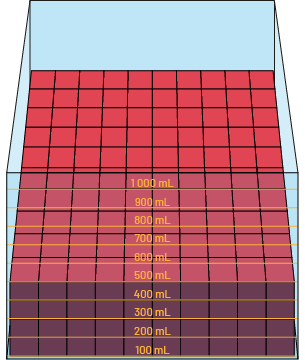B2.2 Understand and recall commonly used percents, fractions, and decimal equivalents.
Activity 1: The Cube (Using Commonly Used Percents, Fractions and Decimal Numbers)
Materials
- Transparent cubes that holds base ten blocks (1000 small cubes)
- 9 hundreds flats
- 9 tens rods
- 10 small (unit) cubes


Task: Represent a quantity in the cube using the flats, rods and small cubes and using percents, fractions and decimal numbers.
Suggestions
- Begin the activity by placing 9 flats, 9 rods and 10 small cubes in the transparent cube.
What quantity is represented in the cube?
Represent this quantity as a percent, fraction and decimal number.
Answer
The full cube = 100% = \(\frac{1}{1}\) =1.0
* The full cube represents the whole.
- Place 5 flats in the cube.
What quantity is represented in the cube?
Represent this quantity as a percent, fraction and decimal number.
- Place only the 10 small cubes.
What quantity is represented in the cube?
Represent this quantity as a percent, fraction and decimal number.
It is important to place quantities in the cube that represent commonly used percentages/fractions/decimal numbers to help the student develop a mental representation of their values
Examples
1%, 5%, 10%, 12.5%, 25%, 50%, 75%, 100%
With these benchmarks, question students so that they can make connections as they deduce the new quantity in the cube.
- Place 20 small cubes in the transparent cube.
What quantity is represented in the cube?
Represent this quantity as a percent, fraction and decimal number.
The students can do the work over time, but if they know that 10 squares are equal to 1%, then if they double the number of small cubes then 20 small cubes should be 2% of the total amount. This type of exercise helps with understanding the concept.
Variation
If a lot of base ten blocks are available, place a cube with a different quantity at each table, divide the students into teams of three, and make different work stations.
Activity 2: Face-To-Face (Mental Math and Percents, Decimal Numbers and Equivalent Fractions)
Materials
- cards with statements
Two students sit face to face. One of the students has a series of cards and turns them over one at a time to the other student, who must answer as many problems correctly as possible. Students then discuss their strategies.
Examples of problems on the cards
- Card 1: 50% is equivalent to ?
- Card 2: If \(\frac{1}{5}\) = 20% then \(\frac{3}{5}\) is = ?
- Card 3: What percent is \(\frac{2}{8}\) equal to?
- Card 4: \(\frac{1}{{100}}\) is equivalent to?
- Card 5: There are 100 blocks on the table. A student takes \(\frac{3}{4}\) of them. How many blocks did the student take?
- Card 6: 0.05 of $1000 = ?
- Card 7: If 1% = 0.01 then 5% = ?
- Card 8: What percent does half of \(\frac{1}{4}\) represent?
